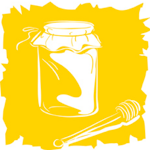 Receta Plastic Bag Ice Cream
Receta Plastic Bag Ice Cream
Ingredientes
|
|
Direcciones
- Overview: In this activity students will learn how to lower the freezing point of water and how ice cream forms as a solution freezes. This activity works best when students are directed to follow the instructor's step-by-step demonstration.
- Prelab preparation: Use a permanent marker to mark each plastic c. at the 1/4, 1/2 and the 1 c. levels. This will help the students when they measure the ingredients.
- Procedure: Use the plastic c. to measure 1/4 c. of sugar by filling it to the first mark from the bottom of the c..
- Transfer the sugar into the small bag.
- Fill the plastic c. to the 1/2 mark with lowfat milk. Don't TRANSFER IT TO THE BAG.
- Add in sufficient creamer (1/2 c.) to the lowfat milk to bring the total volume in the c. to the 1 c. mark.
- Add in approximately 1/4 tsp. of vanilla to the lowfat milk/creamer mix. With smaller children the teacher may want to assist the student.
- Carefully transfer the contents of the c. into the small bag that contains the sugar. Close the bag securely.
- Place the smaller plastic bag inside the larger bag.
- Surround the smaller bag with several c. of crushed ice.
- Pour 1/2 to 3/4 of a c. of salt over the ice and seal the larger bag securely.
- Shake bag. Be careful not to put too much pressure on the bags.
- After 10 min check the mix to see if it is frzn. If not, continue shaking.
- When the mix is frzn, simply remove the smaller bag and eat the ice cream directly from the bag. (Add in nuts, fruit or possibly chocolate if you like.)
- Purpose and background: Ice keeps things cool because it absorbs heat energy from its surroundings. The freezing point of a liquid is the temperature at that it turns into a solid. In this activity the salt is added to the ice; it lowers the freezing point and the ice begins to heat.
- In order for the ice to heat it must absorb heat energy from its surroundings (in this case the ice cream mix). This causes the temperature of the mix to drop and the mix freezes.
- Reference: This activity was adapted from a pre-high school chemistry activity presented by Kimberly Granatire and Phillip Murry at a ICE
